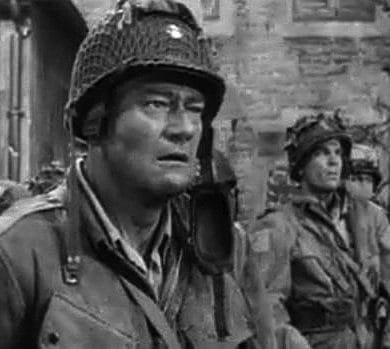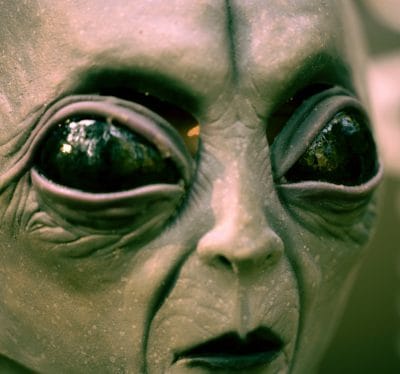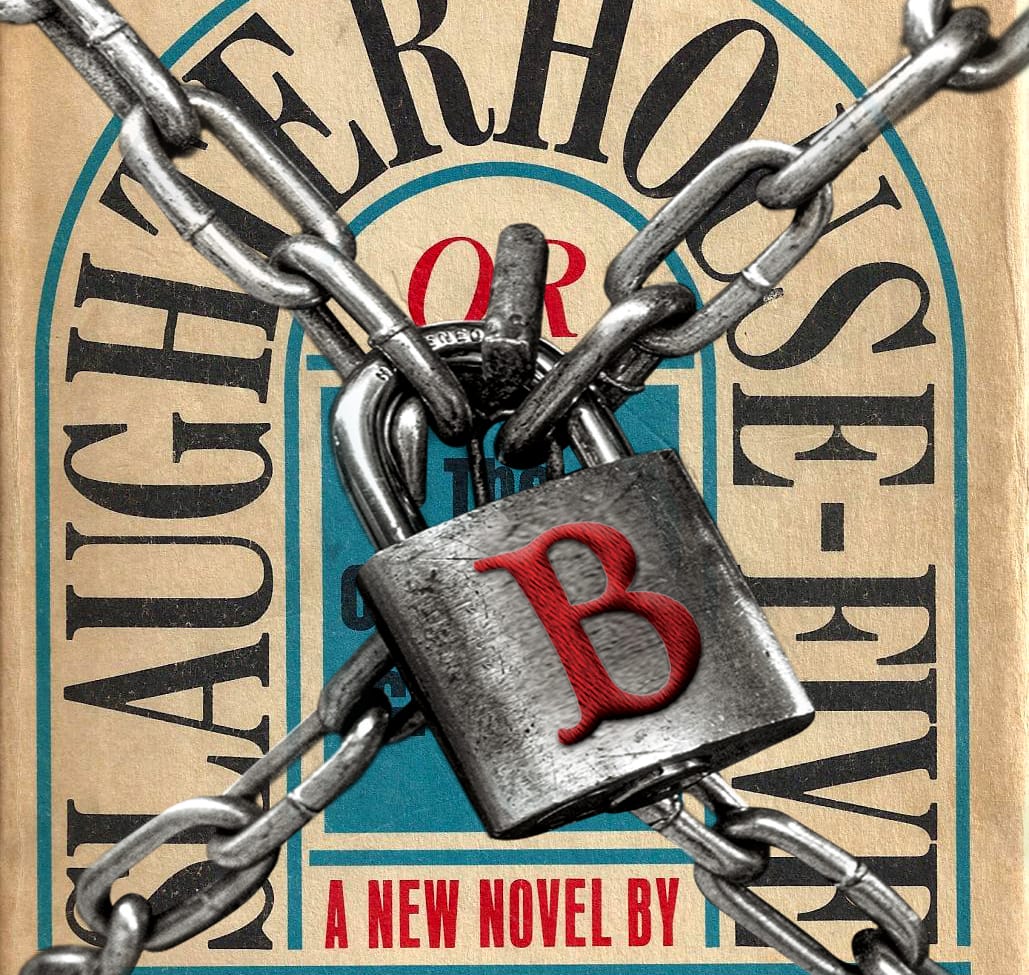Slaughterhouse-Five: Jumbled, Jangled… and Burned.
 laughterhouse-Five revolves around Billy Pilgrim, who like Vonnegut, was a POW in Dresden when it was decimated by Allied firebombing during World War Two.[1] Billy has “come unstuck in time.”[2] And to complicate matters further, he is abducted by aliens, two-foot-tall creatures, who are shaped like toilet plungers, from the planet Tralfamadore.[3]
laughterhouse-Five revolves around Billy Pilgrim, who like Vonnegut, was a POW in Dresden when it was decimated by Allied firebombing during World War Two.[1] Billy has “come unstuck in time.”[2] And to complicate matters further, he is abducted by aliens, two-foot-tall creatures, who are shaped like toilet plungers, from the planet Tralfamadore.[3]
Why was Slaughterhouse-Five banned? Kurt Vonnegut’s searingly sarcastic, darkly funny, science fiction-infused war story is considered one of the greatest anti-war novels of all time. Needless to say, it includes a good dose of rough language, the kind soldiers have been known to use. Bearing both of these things in mind, it’s no surprise that Vonnegut’s novel has been challenged at least eighteen times, with “obscene language,” and “anti-American” sentiment or “lack of patriotism,” consistently among the objections.[4] But as always, some challenges were more successful than others.
A petition to remove Slaughterhouse-Five (among other books) from the junior high and high school libraries of Island Trees Union Free Public School District, made it to the US Supreme Court. Fortunately, citing the First Amendment, the court found that these books could not be removed from the school district’s libraries.[5]
On the other hand, there’s Drake, North Dakota, a banning that got Vonnegut’s personal attention. In 1973, school officials voted to withdraw Slaughterhouse-Five from the curriculum. Most students, however, didn’t want to give up their copy of the novel. So, lockers were searched, books confiscated, and all 32 copies were ultimately burned in the school’s furnace.[6]
The event made national headlines. And Vonnegut sent a biting letter to the chairman of the Drake School Board, who apparently couldn’t fathom what all the fuss was about. In his typical no-holds-barred style, Vonnegut stated what to many of us is obvious:

If you were to bother to read my books, to behave as educated persons would, you would learn that they are not sexy, and do not argue in favor of wildness of any kind. They beg that people be kinder and more responsible than they often are. It is true that some of the characters speak coarsely. That is because people speak coarsely in real life. Especially soldiers and hardworking men speak coarsely, and even our most sheltered children know that.[7]
Vonnegut concluded his letter by summing up the stand against censorship book burning like only he can:

Perhaps you will learn from this that books are sacred to free men for very good reasons, and that wars have been fought against nations which hate books and burn them… it was a rotten lesson you taught young people in a free society when you denounced and then burned books—books you haven’t even read. You should also resolve to expose your children to all sorts of opinions and information in order that they will be better equipped to make decisions and survive.[8]
To Vonnegut’s point, this book is definitely more than just a stockpile of salty language. But, why is Slaughterhouse-Five important? Like all literature, it’s a snapshot of the culture that produced it. As noted in an earlier post, authors and their works present, analyze, and shed light on the social maladies of their day. When readers look beyond Slaughterhouse Five’s rough language, it’s obvious that this book addresses the devastating aftereffects of war. And the novel’s time-traveling, non-linear structure mimics a debilitating psychological condition, one our soldiers struggle with all too often as a result of their war experience.
_____

No parts for
Frank Sinatra or John Wayne.
Science-fiction tropes may carry Slaughterhouse-Five’s narrative, but Vonnegut’s novel tells the very real tale of a verifiable historical event. In the book’s opening chapter, however, Vonnegut makes it clear that he wrote about the firebombing of Dresden because of its historical significance, rather than simply because it made for an exciting personal war story.[9]
But, Vonnegut doesn’t write from the romanticized, gung-ho perspective prevalent in post-World War Two culture. As he tells us in the novel’s autobiographical first chapter, after an uncomfortable conversation with his war-buddy’s wife (Mary O’Hare, to whom Slaughterhouse-Five is dedicated), he realized that the book he was about to write would add to the cultural mythology that perpetuates war and glamorizes young men’s participation in them.[10] So, Vonnegut made her a promise, vowing that if he ever finished his book and it was made into a movie, there would be no parts for actors like Frank Sinatra or John Wayne. There would be no roles for “glamorous, war loving, dirty old men,” who “make war look just wonderful, so we’ll have a lot more of them.”[11]
Consequently, Vonnegut’s novel doesn’t praise the British bombers who carried out the raid, justify American involvement, or support World War Two generally for that matter. Instead, he wrote about hungry and sick prisoners of war. He tells us about a good man who survives the bombing but is executed for picking a teapot out of the rubble.[12] And as Vonnegut points out in the novel, “there are almost no characters in this story, and almost no dramatic confrontations.”[13] He wrote it this way because “one of the main effects of war, after all, is that people are discouraged from being characters,” by which he means being seen as human beings.[14]
_____
Why is Slaughterhouse-Five’s
1969 publication date significant?
As also mentioned in a previous post, the period a book was written in can tell us a lot. And Slaughterhouse-Five’s 1969 publication date, nearly twenty-five years after Vonnegut’s release from a repatriation camp in France, is definitely noteworthy.[15] It’s significant for a couple of reasons. First, because dissent toward the Vietnam war finally freed writers to report on World War Two events that “made war look so ugly.”[16] The time frame is also pertinent because it is during this period that Mental Health professionals began defining the symptoms of PTSD, and advocating for an official diagnosis for this debilitating effect of war.[17] This tidbit of medical history is relevant because Billy Pilgrim, Slaughterhouse-Five’s haunted protagonist, appears to be “a text-book sufferer of PTSD.”[18]
Some significant insight into PTSD is that it’s caused by more than the trauma itself. The “psychosocial atmosphere” of the society soldiers are returning to can, and often does, hinder the process of coping with traumatizing events.[19] And this situation can be observed in Slaughterhouse-Five. When Billy comes home after the war, the environment in America isn’t conducive to working through the trauma he experienced as a soldier.
Shortly after he returns from the war, Billy resumes optometry school. By the middle of his final year, he has himself committed to a veterans’ hospital for non-violent mental patients. And though the doctors agree that Billy was indeed “going crazy” (as Vonnegut describes it), “they didn’t think it had anything to do with the war.”[20] Billy’s doctors were certain his issues could only have stemmed from childhood experiences.
This scene reflects the medical history noted above. PTSD wasn’t even on the medical community’s radar until the the Vietnam war. And it wasn’t recognized as a diagnosable psychological disorder until 1980.[21]
As Vonnegut’s remarks about Hollywood films suggest, prior to the emergence of the social movement that opposed the Vietnam war, American culture considered battle experience to have a positive, maturing effect on young men.[22] Billy’s son, Robert, embodies this notion. He was a sixteen-year-old alcoholic who flunked out of high school. But after a couple tours in Vietnam, “he was all straightened out now.”[23] It’s no coincidence that Robert is a Green Beret in the Marine Corps. A very famous film titled The Green Berets had been released just the year before Slaughterhouse-Five was published. And it starred the selfsame John Wayne that Mary O’Hare called out as bearing responsibility for glamorizing war.
There’s also the gung-ho, political American mindset that kept information about Dresden quiet for so many years. Vonnegut put this attitude in the mouth of Professor Rumfoord, Billy’s hospital roommate following the airplane crash that killed everyone but Billy. When asked why Dresden would be kept a secret for so many years, Rumfoord answered, “For fear that a lot of bleeding hearts… might not think it was such a wonderful thing to do.”[24]
The culture that emerges from these commonly held perspectives prevented the negative effects of wartime experience and resultant PTSD from being taken seriously.[25] But as Rumfoord was finally forced to acknowledge that Billy had indeed been in Dresden during the Allied firebombing, PTSD was finally recognized as a trauma-related condition.
_____

Billy Pilgrim, “unstuck in time”,
a text-book case of PTSD.
Vonnegut himself describes Slaughterhouse-Five as being “jumbled and jangled.”[26] And his non-linear structure resembles the most common symptom of PTSD, “re-experiencing… when a person involuntarily and vividly relives the traumatic event.” [27] This can occur through nightmares, repetitive images and sensations, or it can take the form of flashbacks.[28]
One form of re-experiencing is reflected in Vonnegut’s repetition of particular phrases. These phrases function as both a psychological and narrative linking device, repeatedly returning both Billy and the reader to the war. One example is the oft-repeated image of “blue and ivory feet,” which Billy first saw on corpses while being marched to a POW camp.[29] There’s also the frequently referenced “smell of roses and mustard gas,” whose first chronological encounter occurred in the corpse mines of Dresden.[30]
And then, there’s Vonnegut’s protagonist, Billy Pilgrim, who he describes as having “come unstuck in time.”[31] Billy time travels, spontaneously and frequently. And the fact that Billy has no control over what part of his life he’ll find himself in, echoes the flashbacks experienced by many who suffer from PTSD.
Flashbacks occur in cases of PTSD because the process of memory consolidation is short-circuited. Familiar, non-stressful events are automatically assimilated and the information in our brain’s “active memory storage” is rapidly eliminated. But that’s not the case with traumatic events.[32] As amazing as our brains are, they have a limited capacity for processing. And information associated with extraordinary, stressful events can’t be processed rapidly, so it remains in active memory storage and continues to run in the background, if you will. When a traumatic memory is triggered, it inserts itself into active consciousness, like pop-ups on websites if you don’t have an ad-blocker.[33]
Specific triggers, things that remind Billy of the war, prompt his time travel/flashbacks. For example, the siren announcing high noon on the firehouse across the street “scared the hell out of him,” and catapults him back in time: “Billy closed his eyes. When he opened them, he was back in World War Two again.”[34] Another triggering instance occurs when Billy was in the mental ward, and his room-mate is reading a book:

Billy fell asleep under his blanket. When he woke up again, he was tied to the bed in the hospital back in prison. He opened one eye, saw poor old Edgar Derby reading The Red Badge of Courage by candlelight.[35]
Like the repeated phrases mentioned above, Billy’s time travel/flashbacks also function as a linking device, repeatedly returning both Billy and the reader to the war.

A great big secret somewhere inside.
The barbershop quartet at Billy’s anniversary party also triggers a war-related memory. But this time, his response is very different. Rather than having a flashback/time traveling:

His mouth filled with the taste of lemonade, and his face became grotesque, as though he really were being stretched on the torture engine called the rack. He looked so peculiar that several people commented on it solicitously when the song was done. They thought he might have been having a heart attack… [36]
While coming unstuck in time is the result of a memory that has been partially processed, the barbershop quartet triggers Billy’s response to a memory that had been suppressed. So, even Billy himself didn’t understand why the song evoked such anguish. He finally realizes that the barbershop quartet reminded him of the expressions on the faces of four gobsmacked German guards as they take in the sight of the freshly devastated Dresden.[37] When everyone, guards and prisoners alike, emerged from the meat locker they were sheltering in:

… the sky was black with smoke. The sun was an angry little pinhead. Dresden was like the moon now, nothing but minerals. The stones were hot. Everybody else in the neighborhood was dead.[38]
The bombing of Dresden is the epicenter of Billy’s trauma. As such, it was not just too frightening to relive, but too painful to even remember. So he suppressed the memory altogether, that is until it was triggered by the barbershop quartet.[39]
_____
What’s with the Tralfamadorians?
Billy’s roommate in the mental hospital, Eliot Rosewater, introduced Billy to the science fiction books of Kilgore Trout. Rosewater had been an infantry captain in the war, and he and Billy were both feeling the “sense of dislocation and absurdity” frequently experienced by survivors of atrocity, a sensibility that destroys their previous assumption of a rational universe.[40] So, as Vonnegut specifically tells us, Billy and Rosewater use science fiction to “re-invent themselves and their universe.”[41]
One of the books Billy read while he was in the mental hospital was titled Maniacs in the Fourth Dimension. It helped Billy understand why his doctors couldn’t fix what was wrong with him. According to Trout’s book, “mental diseases couldn’t be treated because the causes of the diseases were all in the fourth dimension.”[42] So, Billy’s three-dimensional Earthling doctors weren’t actually incompetent. They couldn’t identify the cause of his problems, because they were unable to see them. Rather like the way the psychosocial atmosphere in America hindered Mental Health professionals from identifying PTSD prior to the Vietnam era.
The Tralfamadorian concept of time offers Billy an explanation for his flashbacks. According to the Tralfamadorians, the notion that moments occur one after another, and are gone forever once they have past, is merely an illusion we have here on Earth. Tralfamadorians can:

…look at all the different moments just the way we can look at a stretch of the Rocky Mountains, for instance. They can see how permanent all the moments are, and they can look at any moment that interests them.[43]
This is an apt description what happens in a flashback. All moments are active. As mentioned earlier, the brain hasn’t finished processing traumatic memories and removed them from active memory storage. And when a particular moment is triggered, indicating interest in that moment, the subject (re-)experiences it.
As a result of their understanding of time, when Tralfamadorians see a corpse they merely think the dead person is in a bad state at that precise moment. That same person is in fine shape in plenty of other moments. A passage within Slaughterhouse-Five that overlaps the moment when Billy’s entire company was killed with a moment of camaraderie during boot camp, indicates the psychological benefits of seeing time in this way.
Billy’s fellow soldiers were merely “theoretically dead.”[44] And these “theoretical corpses” were still able to laugh and eat “a hearty noontime meal.”[45] Recalling the incident some years later, “Billy was struck by what a Tralfamadorian adventure with death that had been, to be dead and to eat at the same time.”[46] In short, understanding time as the Tralfamadorians do provides Billy with the tools to get a handle on his condition. These tools also allow him to cope with the vast amount of death he witnessed in the war, which caused his condition in the first place.
_____

Why are aliens
intertwined with Billy’s PTSD?
Once again, Vonnegut’s use of aliens reflects what was going in American culture when he was writing his novel. At the time Slaughterhouse-Five was published, the Roswell incident had been in American culture for about twenty years. And reports of alien encounters were beginning to crop up. These alien abduction stories indicate that, during this period, science fiction has gone beyond merely being a genre of fiction to become a way of looking at the world.[47]
It’s interesting to note that the first widely publicized account came from someone who, like Billy Pilgrim, was a World War Two veteran. The fact that this abductee said the alien in charge reminded him of “an evil-faced German Nazi” officer is intriguing indeed.[48] This shared characteristic with Billy Pilgrim is especially compelling, given that he also noted a similarity between the “precision of movement” the alien crew exhibited when they moved as a group, and German soldiers.[49]
Studies of alien abduction accounts indicate that, along with other phobias and aversions, subjects commonly experience a confused temporality and gaps in time. These symptoms are frequently related to trauma, which as we have seen, often disrupts memory assimilation. In order for the subject to protect themselves from remembering the event that created their psychic wound, these gaps in time demand to be filled.[50] After the Roswell incident “proved” the existence of extraterrestrials, an alien abduction story is the perfect way to account for this missing time.
_____
In Conclusion.
Slaughterhouse-Five is clearly more than a jumbled bag of sarcastic anti-American rhetoric, sprinkled with a good dose of rough language. Like all literature, Vonnegut’s novel reflects what was going on in the culture that produced it. Even if, like PTSD prior to the Vietnam era, it doesn’t have a name yet. This book does more than just talk about the devastating after-effects of war, however. It gives engaged readers a very small taste of what it’s like to try and make sense of the world when suffering from this debilitating psychological condition.
The moral of Slaughterhouse-Five is simple, War is Hell. By showing us how damaging trauma is, especially on the scale endured as a result of World War Two, Vonnegut does indeed make the case for why people need to be kinder and more responsible than they often are.
That’s my take on Slaughterhouse Five – what’s yours?
Check out this discussion guide to get you started.

Endnotes:
[1] Powers, Kevin. “Forward.” Slaughterhouse-Five. (New York: Modern Library, 2019), xi.
[2] Vonnegut, Kurt. Slaughterhouse-Five. (New York: Modern Library, 2019), 25.
[3] Vonnegut, Slaughterhouse-Five, 28.
[4] Morais, Betsy. “The Neverending Campaign to Ban “Slaughterhouse-Five.’” The Atlantic, August 12, 2011; Henriksen, Megan. “Kurt Vonnegut, ‘Slaughterhouse-Five.’” The Banned Books Project @Carnegie Mellon University. September 12, 2019.
[5] Board of Education, Island Trees Union Free School District No. 26 et al., Petitioners, v. Steven A. PICO, by his next friend Frances Pico et al. https://www.law.cornell.edu/supremecourt/text/457/853.
[6] Johnson, Hannah. “40 years later, the resentment still smolders.” The Bismarck Tribune. Nov. 10, 2013; Stevens, William K. “Dakota Town Dumfounded at Criticism of Book Burning by Order of the school Board.” The New York Times, Nov. 16, 1973.
[7] Vonnegut, Kurt. Palm Sunday: An Autobiographical Collage. (New York: Dial Press Trade Paperbacks, 2011), 4-5.
[8] Vonnegut, Palm Sunday, 6.
[9] Laufert, Wayne. “From the Slaughter.” The Humanist.com (Feb. 19, 2019).
[10] Kunze, Peter C. “For the Boys: Masculinity, Gray Comedy, and the Vietnam War in ‘Slaughterhouse-Five.’” Studies in American Humor. New Series 3, No. 26, Special Issue: Kurt Vonnegut and Humor (2012), 45.
[11] Vonnegut, Slaughterhouse-Five, 17, 16.
[12] Laufert, “From the Slaughter.”
[13] Vonnegut, Slaughterhouse-Five, 168.
[14] Vonnegut, Slaughterhouse-Five, 168.
[15] Solly, Mellan. “Kurt Vonnegut’s Unpublished World War II Scrapbook Reveals Origins of ‘Slaughterhouse-Five.’” Smithsonianmag.com (Dec. 14, 2018).
[16] “‘Slaughterhouse-Five’ at 50.” 2003 Interview with Renee Montagne. NPR radio. (June 6, 2019).
[17] Scott, Wilbur J. “PTSD in DSM-III: A Case in the Politics of Diagnosis and Disease.” Social Problems, Vol 37, No. 3 (Aug., 1990).
[18] Kavanagh, Ciaran. “Diagnosing Kurt Vonnegut: A Response to Susanne Vees-Gulani on the Subject of Slaughterhouse-Five.” IJAS (Irish Journal of American Studies.) Online, No. 5 (2016), 14.
[19] Kleber, Rolf J., Charles R. Figley, and Bertold P. R. Gersons. Beyond Trauma: Cultural and Societal Dynamics. The Plenum Series on Stress and Coping. (New York: Plenum, 1995), 2.
[20] Vonnegut, Slaughterhouse-Five, 103.
[21] Friedman, Matthew J. A Brief History of the PTSD Diagnosis. PTSD: National Center or PTSD.
[22] Bracken, Patrick J. “Post-modernity and post-traumatic stress disorder.” Social science & Medicine. Vol 53 (2001), 734.
[23] Vonnegut, Slaughterhouse-Five, 194.
[24] Vonnegut, Slaughterhouse-Five, 195.
[25] Bracken, Post-modernity and post-traumatic stress disorder, 735.
[26] Vonnegut, Slaughterhouse-Five, 21.
[27] Symptoms: Post-traumatic stress disorder (PTSD). https://www.nhs.uk/conditions/post-traumatic-stress-disorder-ptsd/symptoms/
[28] Symptoms: Post-traumatic stress disorder (PTSD).
[29] Vonnegut, Slaughterhouse-Five, 68.
[30] Vonnegut, Slaughterhouse-Five, 219; Kavanagh, Ciaran. “Diagnosing Kurt Vonnegut: A Response to Susanne Vees-Gulani on the Subject of Slaughterhouse-Five.” IJAS (Irish Journal of American Studies.) Online, No. 5 (2016), 14.
[31] Vonnegut, Slaughterhouse-Five, 25.
[32] Horowitz, Mardi J. Stress Response Syndromes: PTSD, Grief, Adjustment, and Dissociative Disorders. (Northvale, NJ: Jason Aronson, Inc., 2011), 84.
[33] Horowitz, 84-85.
[34] Kavanaugh, 14; Vonnegut, Slaughterhouse-Five, 60.
[35] Vonnegut, Slaughterhouse-Five, 108.
[36] Vonnegut, Slaughterhouse-Five, 177.
[37] Kavanaugh, 14-15.
[38] Vonnegut, Slaughterhouse-Five, 182.
[39] Kavanaugh, 14-15.
[40] Lifton, Robert J. “Beyond Atrocity.” Saturday Review. (March 27, 1971), 23.
[41] Vonnegut, Slaughterhouse-Five, 104.
[42] Vonnegut, Slaughterhouse-Five, 107.
[43] Vonnegut, Slaughterhouse-Five, 29.
[44] Vonnegut, Slaughterhouse-Five, 33.
[45] Vonnegut, Slaughterhouse-Five, 33.
[46] Vonnegut, Slaughterhouse-Five, 34.
[47] Luckhurst, Roger. “The Science-Fictionalization of Trauma: Remarks on Narratives of Alien Abduction.” Science Fiction Studies. Vol. 21, No. 1 (March, 1998), 29.
[48] Friedman, Stanton T. and Kathleen Marden. Captured!: The Betty and Barney Hill UFO Experience. (Franklin Lakes, NJ: New Page Books, 2007), 136.
[49] Friedman, 108.
[50] Luckhurst, 37.
Images:
Cover – 1st edition. Vonnegut, Kurt. Slaughterhouse-Five. (New York: Delacorte Press, 1969). Jacket design by Paul Bacon” is found on the left jacket flap. (For jurisdictions that define copyright term on the date of the author’s death: according to this article, Bacon died in 2015.) – AbeBooks (direct link to jpg)., Public Domain, https://commons.wikimedia.org/w/index.php?curid=80843456
No Parts for John Wayne or Frank Sinatra. “The Longest Day.” trailer screenshot (20th Century Fox), Public domain, via Wikimedia Commons
Billy Pilgrim, a Text-book Case of PTSD. Photo by Ahmad Ossayli on Unsplash https://unsplash.com/photos/laJW5pp-6Yw?utm_source=unsplash&utm_medium=referral&utm_content=creditShareLink
A Great Big Secret Somewhere Inside. Photo by Edge2Edge Media on Unsplash https://unsplash.com/photos/x21KgBfOd_4?utm_source=unsplash&utm_medium=referral&utm_content=creditShareLink
Why are Aliens Intertwined with Billy’s PTSD? Photo by Stephen Leonardi on Unsplash https://unsplash.com/photos/sMPRCsoUM4A?utm_source=unsplash&utm_medium=referral&utm_content=creditShareLink
